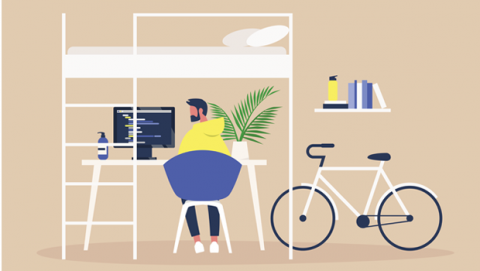The other day, I had sort of an epiphany. I was trying to finish some slides for a presentation, and the only thing I could think about was being out in my workshop, chopping out a mortise for a chair leg.
For an hour or two, I was miserable, and I think I got one slide done – poorly. Chopping the mortise, on the other hand, I can do in about 15 minutes. So I decided to do the unthinkable: I checked my calendar, got up from my desk, went out to the shop, and chiseled out a beautiful mortise. Then I came back in, finished my meeting prep, and enjoyed a productive meeting.
No timeboxes. No deep breathing. No buckle-down, saddle-up, get-it-done attitude-shifting. Instead, I gave in – and it worked.
A host of time management "solutions"
I’ve spent my share of time on Google (itself a bottomless well of distraction) and found a trove of techniques, tricks, and mind hacks to keep distractions at bay and stay focused: Pomodoro…three goals a day…ooh, a meditation app!..maybe I’ll try Trello again… Countless solutions are on offer, from the practical to the spiritual.
These techniques are great for some people. But then there are the rest of us, who have tried everything from Franklin Covey to Wim Hof (I’m still shivering thinking about that one) and still find ourselves sorting our mail, re-organizing our desks, or staring at the cat while PowerPoint glares balefully back at us. Why don’t the tricks work for us?
One thing that all these approaches have in common is a heavy reliance on discipline – the very thing that distractions devour. For many of us, these techniques become just another thing to get distracted from (or even a new distraction in themselves – who’s up for some to-do-list-making?). Even simple tips like setting three goals every day can become less a helpful tool than something to beat ourselves up over when we falter.
Not all distractions are equal
Moreover, most of these techniques treat all distractions the same – but it ain’t so. There are basically two kinds of distractions: escape hatches and neglected priorities.
Escape hatches are things we do specifically to avoid doing something else (social media is a prime example). They don’t have much value in and of themselves – so a containment or elimination strategy makes sense. Put down the Twitters, people – that cat video isn’t going anywhere, and you wouldn’t miss it if it did.
When priorities become distractions
Neglected priorities, on the other hand, are things that are worth doing; the urge to do them just crops up at inopportune moments. These range from the practical (getting coffee and realizing the dishwasher needs to be emptied) to the spiritual (an idea for a blog entry or a personal project that is calling you from the garage).
[ Does remote work leave you exhausted? Read our related story: Remote exhaustion: 13 tips to reduce fatigue. ]
Trying to put these distractions aside, or limiting them to five minutes out of every 25 as Pomodoro suggests, doesn’t reduce the distraction level – because the tasks are important, and there is nothing magical about the hours from 8 am and 6 pm that changes that.
When it comes to neglected priorities, what actually gets in the way of productivity is the idea of the unaddressed work. For me, putting these distractions on an attention-starvation diet simply causes them to gnaw at my brain, preventing me from doing anything that requires thought.
Remote work: The pandemic turning point
At some point I realized that the very thing – proximity – that made these neglected priorities so hard to ignore could be used to my advantage. So I simply reorganized my day to accommodate them.
Pre-pandemic, the workday for many of us encompassed all the time between waking up and getting home in the evening. Now, as long as we get our work done and show up for meetings and other time-specific commitments, it doesn’t really matter what time we do things.
That means I can schedule in my formerly neglected priorities as equal constituents of my day. I don’t have to come in late or knock off early just to run an errand, keep a personal appointment, or spend a few extra minutes with the kiddos. Work-life balance has become work-life integration.
And the truth is, I probably spend more hours doing my job now than I did before. I don’t feel like I’m wasting time “on the clock” when I break up the day, nor do I feel like I’m working late when I plan a workshop at 10:30 or 11:00 pm. The best part? I enjoy all of it more! I remember that I like my work and that it doesn’t have to subjugate my other priorities. It all matters, and it all gets done.
4 work-life integration tips
If you also struggle with distraction, here are a few tips to help you take a more holistic approach to your work and your life.
Learn to spot neglected priorities. The difference between a real priority and an escape hatch can be subtle. Ask yourself: Will I be disappointed in myself if I don’t do x? If yes, x is likely a priority. Also, if you feel the urge to do something only when you’re up against doing something else, that urge probably points to an escape hatch.
Let go of the segmented day. Try to avoid thinking in terms of working hours versus non-working hours. This mindset goes both ways, so your evenings and weekends will be less “protected,” but on the other hand, you may not mind spending a few weekend hours on the job if you don’t feel like you’re robbing your own time bank.
Keep commitments. This one does require a little discipline: If something is time-sensitive or has a deadline, don’t let it slip. This can become an Achilles’ heel when you adopt a more flexible approach to work. But you may also find that it is easier to do once you remove the old artificial restrictions.
Maintain some downtime. Being productive feels great, but we all need time to recharge our batteries (let’s just say my kids are not the only ones who make use of the PlayStation). So be sure to build in time to relax, play, and sleep.
[ Get exercises and approaches that make disparate teams stronger. Read the digital transformation ebook: Transformation Takes Practice. ]






